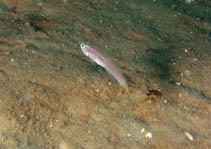| Family: |
Gobiidae (Gobies), subfamily: Gobiinae |
| Max. size: |
10 cm SL (male/unsexed) |
| Environment: |
reef-associated; marine; depth range 0 - 36 m |
| Distribution: |
Western Atlantic: North Carolina, USA and eastern Gulf of Mexico to the Lesser Antilles. |
| Diagnosis: |
Distinguished by the following characteristics: general body color is light grey-brown, typically have areas of very bright iridescent blue and/or yellow; body is laterally compressed; large, nearly vertical mouth; completely scaled body; first dorsal with VII spines; ventral fins are united (Ref. 92840). |
| Biology: |
Burrows in bottom in open stretches of coarse sand. Often hovers over burrow. Also known to inhabit mangrove streams with very fine silt-mud substrate (Ref. 92840). |
| IUCN Red List Status: |
Least Concern (LC); Date assessed: 01 March 2010 Ref. (130435)
|
| Threat to humans: |
harmless |
Source and more info: www.fishbase.org. For personal, classroom, and other internal use only. Not for publication.
